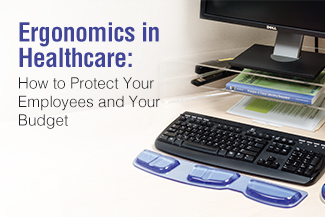Your healthcare organization cannot afford to disregard any complaints of discomfort from its employees.
That doesn’t necessarily mean every worker should be provided with a personal masseuse.
What it does mean is that every sore foot, aching back, and kinked neck is worth careful consideration, for a number of reasons. First and foremost, employees are happier and better at their jobs when they’re not in pain. Secondly, work-related musculoskeletal disorders (WMSDs) cost employers an average of $12,000 per injury, which includes lost work with full wages, replacement wages, lost productivity, and medical treatment not including surgery.
WMSD rates among healthcare workers caused by overexertion are among the highest of all U.S. industries – as high as five times the national average, depending on occupation type, according to the CDC.
So how can we reduce the number of caregivers who become care recipients? 
The answer is supporting healthcare professionals with ergonomic solutions designed to protect their health and help them provide the best patient care.
Here are five essential steps for improving the ergonomics of your healthcare environment.
Ask questions: If one of your employees mentions a chronic ache in his right shoulder, don’t just sympathize. Ask how long they’ve noticed it. Consider watching their working patterns for a while if it’s not too big of a distraction. You don’t always have to be a physical therapist to notice a certain repetitive motion or movement that could be problematic. The cause may be a workflow issue whose solution is as easy as moving a tube rack.
Be a seating scout: As the science of ergonomics continues to evolve, furniture manufacturers are getting better at developing chairs and stools that offer maximum comfort for a great value. Choose ergonomic seating solutions based on the unique needs and responsibilities of your floor or department. There is a type of seating that’s best for every job. It’s just a matter of finding it. Also, keep in mind that sometimes a simple accessory component, such as an add-on backrest, is all you need to make your existing seating perfect for you.
Don’t cheap out on mats: There is more to mat selection than cost and durability. Yes, you want a mat that lasts for the best price, but don’t you also want your standing employees to be as comfortable as possible? It’s amazing what a nice, affordable anti-fatigue mat can do for your workers spirits and their feet.
Improve patient transport: Transporting patients is one of the biggest causes of WMSDs. Of all healthcare workers, ambulance workers experience 174 such injuries per 10,000 workers. Make sure workers are exerting themselves as little as possible when pushing and lifting. Wheelchair extension handles and high-quality lateral transfer boards are excellent investments.
Invest in workstation solutions: Some of these are among the most affordable ergonomic changes you can implement. If a there’s a chance that a $20 wrist rest could help prevent a $7,000 carpal tunnel surgery, doesn’t that seem like a reasonable choice? Instead of gutting your nurse station or receptionist area, why not see if a $59 monitor stand will do the trick?
Got questions on our ergonomics tips? Please leave them in the comment box below!
